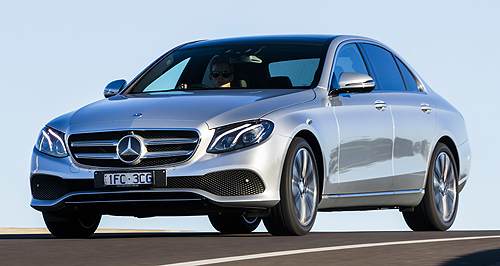Make / Model Search
News - Mercedes-BenzBenz to cover 100,000km in Aus safety testingSafe bet: Mercedes-Benz is using an E-Class to test its latest generation of active safety systems in Australia. Big plans for big Australia in Mercedes-Benz research regime31 Mar 2017 MERCEDES-BENZ has committed to driving up to 100,000km within a year in its E-Class active safety system prototype in Australia, revealing an expanded test regime that has so far centred around Germany, the United States, South Africa and China. Announced last week, the ‘pilot’ project would use Mercedes-Benz Australia/Pacific employees to drive normally around the country to document if and when any of its forward and side collision warnings, autonomous emergency braking (AEB), active swerve assist and lane-keep assistance functions trigger. With a forward and rear-facing stereo camera and a ‘trigger’ button for the driver to log when an odd or unexpected event occurs, the standard-looking E-Class has equipment in its boot that can then gather 6Gb of data per hour to send back to German research and development (R&D) headquarters for analysis. The aim is to gather data from unique driving styles and conditions around the world, in order to fine-tune active safety systems as Mercedes-Benz continues to work towards driverless, fully autonomous driving within a decade. Speaking with GoAuto at the national media launch of the Mercedes-AMG E43 in Melbourne last week, Mercedes-Benz manager of validation and communication for active safety and assistance systems, Jochen Haab, revealed further details of the program that will run between Australia and Germany. “We’re looking at a year or so,” Mr Haab said of the timeframe of the program. “(The E-Class) is a car owned by MB Australia, so it’s (going to be running) at least until the S-Class is launched, which is the last quarter of the year. “It’s a pilot project, it’s the first time we’ve done it in such a remote location from our perspective. Date transfer is a big issue, we don’t have an R&D team here, we have a great technical team from a service point of view, they were trained in the software we’re using and the measuring devices. “We have some R&D teams in China, in the US, and one in South Africa, so this is really a first timer, it’s a pilot for many things but also how can we deal with it with normal people, no engineers.” Mr Haab revealed that German engineers would not be based in Australia, but rather the different time zones meant that using specialist technical teams to transfer daytime data from our country to Europe by their morning worked well. Rather than driving the E-Class in a particularly harsh way during testing, he added that it was instead important to find abnormalities in completely normal driving situations. “We’re looking for everyday data, you have a trigger in that car, as we measure continuously (drivers can place) a marker and we can look into that,” he explained. “If you say this (occurrence) was really weird, it would help us if the driver took a small speech note or wrote it down. Because we have cameras which can show us the situation, upcoming and ever after, on the front and out the back too, we can then assess the situation with our experience and look into what the data did, what the car actually ‘thought’. “In sheer statistics we will run into forward collision warnings, we will run into some pedestrian warnings, we will run into some curves that the navigation might not know.” Mr Haab noted two examples of driving conditions that were of particular interest in the Australian program, including flashing variable speed limit signs, and also sand and dust along the coast and outback that could cover lane markings required for the lane-keep assistance systems to function properly. Mercedes-Benz Australia Pacific will facilitate the route of the E-Class prototype, which has already started collating information in Melbourne and towards Lorne on Victoria’s south coast. “Let’s say we would be very happy if it (the number of kilometres travelled) was a four-digit number every week,” Mr Haab added. “If you’re looking into a year, somewhere between 50,000km and 100,000km would be great, (in the) one car.” The E-Class has not been fitted with special safety hardware beyond that of the standard production model, however its software has been updated from to the newer program set to debut in the S-Class in November (see separate story). Using Mercedes-Benz Australia/Pacific employees only, driver and data numbers from the local E-Class program will add to the sizeable figure already attained from overseas testing in seven years. “(We have travelled) nine million kilometres in Germany, US and China so far, and a little bit in South Africa,” Mr Haab said of the research tally so far. “We had 4600 test drivers in seven years (and tallied) more than one million measurements which have given us half a million events, which is things that we thought we should look at, from a collision warning to a curve being cut because it saw something it shouldn’t have seen. “Then we can put something into the software so the customer won’t encounter it.”  Read more29th of March 2017  Mercedes S-Class facelift here in NovemberBenz’s updated S-Class can now swerve around obstacles, and more21st of March 2017  Mercedes-Benz tests safety tech on Aussie roadsSafety system development by Mercedes Aus and German R&D team begins on local roads |
Click to shareMercedes-Benz articlesResearch Mercedes-Benz Motor industry news |











Facebook Twitter Instagram